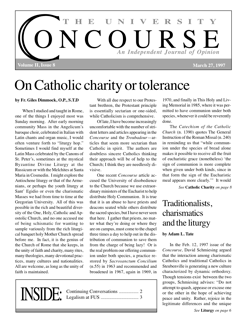On Catholic charity or tolerance
by Fr. Giles Dimmock
When I studied and taught in Rome, one of the things I enjoyed most was Sunday morning. After early morning community Mass in the Angelicum’s baroque choir, celebrated in Italian with Latin chants and organ music, I would often venture forth to “liturgy hop.” Sometimes I would find myself at the Latin Mass celebrated by the Canons of St. Peter’s, sometimes at the mystical Byzantine Divine Liturgy at the Russicum or with the Melchites at Santa Maria in Cosmedin. I might explore the Antiochene liturgy or that of the Armenians, or perhaps the youth liturgy at Sant’ Egidio or even the charismatic Masses we had from time to time at the Gregorian University. All of this was possible in the rich and beautiful diversity of the One, Holy, Catholic and Apostolic Church, and no one accused me of being schismatic for wanting to sample variously from the rich liturgical banquet holy Mother Church spread before me. In fact, it is the genius of the Church of Rome that she keeps, in the unity of faith and charity, many rites, many theologies, many devotional practices, many cultures and nationalities. All are welcome, as long as the unity of faith is maintained.
With all due respect to our Protestant brethren, the Protestant principle is essentially sectarian or one-sided, while Catholicism is comprehensive.
Of late, I have become increasingly uncomfortable with the number of strident letters and articles appearing in the Concourse and the Troubadour—articles that seem more sectarian than Catholic in spirit. The authors are doubtless sincere Catholics thinking their approach will be of help to the Church; I think they are needlessly divisive.
One recent Concourse article accused the University of disobedience to the Church because we use extraordinary ministers of the Eucharist to help distribute Holy Communion. It is true that it is an abuse to have priests and deacons seated while others distribute the sacred species, but I have never seen that here. I gather that priests, no matter what they’re doing or where they are on campus, must come to the chapel three times a day to help out in the distribution of communion to save them from the charge of being lazy! Or is the real problem our offering communion under both species, a practice restored by Sacrosanctum Concilium (n.55) in 1963 and recommended and broadened in 1967, again in 1969, in 1970, and finally in This Holy and Living Memorial in 1985, where it was permitted to have communion under both species, whenever it could be reverently done.
The Catechism of the Catholic Church (n. 1390) quotes The General Instruction of the Roman Missal (n. 240) in reminding us that “while communion under the species of bread alone makes it possible to receive all the fruit of eucharistic grace (nonetheless) ‘the sign of communion is more complete when given under both kinds, since in that form the sign of the Eucharistic meal appears more clearly.’” It would seem according to this teaching that the University is not being disobedient, but obedient. When I see people bypassing the chalice containing the Precious Blood, which it is our great privilege to receive, I do not understand their action; but I dare not judge because they have a legitimate option provided by the Church. By the same token if others wish to receive under the fullest sign possible—both species—and if we need extraordinary ministers to do that reverently and expeditiously, then I think it’s not asking too much of my Catholic brothers and sisters to be charitable about or at least tolerant of this practice. Such would be a truly Catholic and not a sectarian response.
In last year’s controversy over liturgical dance, another Concourse article (Did they dance at the crucifixion? November 20, 1996) quite rightly pointed out that dance is forbidden in the West during the Liturgy, although it might be permitted before, and went on to show that the Mass is a sacrifice, as indeed it is. However, in the quote from the Catechism which the author chose to make his point, he omitted the portion referring to the meal aspect of the Mass: “The Mass is at the same time, and inseparably, the sacrificial memorial in which the sacrifice of the Cross is perpetuated and the sacred banquet of communion with the Lord’s body and blood” (n. 1382, emphasis added). O Sacrum Convivium, sang St. Thomas—“O Sacred Banquet”—O sacred meal; a holy sacrificial meal shared by the Church, dining on the Lord Himself. The article downplays the ecclesial dimension of the Mass, doubtless reacting to abuses. The Mass is both a sacrifice and a holy meal celebrated by and for the Church through the priest who acts in persona Christi. A fully Catholic approach of both/and is needed here again and not a sectarian either/or!
Finally, I would like to comment on Pope John Paul’s permitting women to serve at Mass. This is primarily a disciplinary decision of the Holy Father. It is clear that he, forceful leader of the Church who helped to topple the Iron Curtain, was not pushed into such a decision. In fact, he used it as an argument to show women’s advancement in the Catholic Church in his letter to women occasioned by the Beijing conference. One might debate in abstracto whether it was a wise decision for the Western rite, but de facto it is now an option permitted by the Church. I think to wrangle over this issue is divisive and sectarian as well.
I came to Steubenville when invited by Fr. Michael because I shared his involvement in the charismatic movement (I became involved in 1967), but, more importantly because I shared his vision of the Church fully restored and alive with the gifts of the Holy Spirit and the riches of Catholic Tradition. I had studied the Fathers and St. Thomas on the charismatic gifts, but wanted to teach in an atmosphere where they were experienced in a truly Catholic way. I appreciated the vibrant liturgies celebrated with upbeat contemporary music appealing to the young and drawing them towards conversion. Over the course of time, I have seen us evolve and integrate the traditional and charismatic dimensions more fully. I encouraged Latin Mass once a month with Gregorian chant and polyphony; I’ve seen the early morning quiet Mass grow, as well as the Sunday early morning Mass with organ, more traditional hymns and monthly schola. I have applauded Fr. Ronald’s beautiful Sunday sung Vespers and Benediction service. Often I note that some of these services, which are offered for the more traditionally inclined, are poorly attended, as was the marvelous Sacred Music Conference last year. Of course, I agree that students have the freedom in Holy Church to attend Mass downtown at St. Peter’s or traipse into Pittsburgh to attend a Tridentine Mass. I only hope they will accord us the same freedom to use the legitimate options of Holy Church so that the wonderful broad, rich and Catholic vision that Fr. Michael had, and which I cherish, will not be lost in a morass of sectarianism and legalism.
Fr. Giles, who holds a degree in Liturgy from Sant’ Anselmo’s in Rome, is chairman of the theology department at Franciscan University.


